
Live updates and soundbites from the RAC Club, Pall Mall, London – the venue for the 2018 Older Road User Conference.
Summary:
- The inaugural Older Road User Conference takes place at the Royal Automobile Club, Pall Mall, on 19 September
- In association with Satsafe
- Dame Joan Bakewell CBE delivers the opening address
- Soundbites, presentation & images to follow from 9am on 18 September
This page will not automatically refresh, click here to load the latest entries.
16.00 – Ian Edwards, New View Consultants
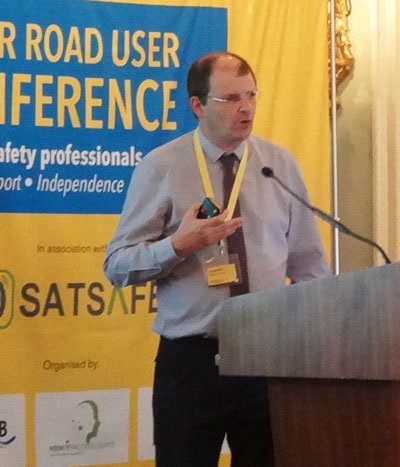 Ian Edwards is an independent road safety consultant who has developed and delivers several of Road Safety GB’s courses, including the Foundation and Behavioural Change course.
Ian Edwards is an independent road safety consultant who has developed and delivers several of Road Safety GB’s courses, including the Foundation and Behavioural Change course.
Ian started his career as a road safety officer in Doncaster before moving to Kirklees, where he was responsible for the delivery of their driver improvement schemes.
Presentation: Assessment or education – what’s the difference?
Assessment or education
- Assessment: recommendations/training delivered based on what the instructor/assessor observes (are we missing an opportunity to deliver educational messages?)
- Education: includes the above, but also includes some type of structured input
“My view is that schemes should be a mix of the two (but many focus on an assessment drive)”
Evaluation of two ‘low level’ mature driver schemes
- Buckinghamshire CC (assessment)
- Merseyside Road Safety Partnership (assessment and short micro lesson covering glare & peripheral vision)
Conclusions
- Not comparing like for like
- Are we missing opportunities by running assessment schemes with no education – I would suggest so
- Consideration should be given to specific subject areas:
- Hazard perception – taught as a specific skill
- Understanding vision and how it can alter with age
A last plea:
Travel plans – think about how you can use your interactions to encourage people to move away from driving.
15.45 – Fiona Fylan, Brainbox Research
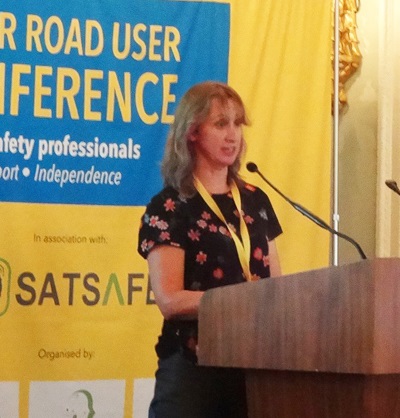 Dr Fiona Fylan is a health psychologist who specialises in understanding the decisions that people make that affect their health and wellbeing, and how to help people make more appropriate or less risky decisions.
Dr Fiona Fylan is a health psychologist who specialises in understanding the decisions that people make that affect their health and wellbeing, and how to help people make more appropriate or less risky decisions.
Fiona’s research addresses a wide range of health-related behaviours and focuses on road user behaviour.
Presentation: Can ‘Driving Safer for Longer’ change behaviour?
What did we find out about existing interventions?
• People who attend the courses aren’t those who most need them
• Important to include both classroom and in-car elements
• In-car areas addressed aren’t specific to aging: –focus on mirror work, positioning and speed, with some driver-centred courses also focusing on roundabouts
Driving safer for longer aims to:
- Enable older drivers to make informed decisions and help them drive safer for longer
- Maintain and improve driving skills (observation, scanning, hazard perception, confidence)
- Increase skills to maintain control of the vehicle
- Improve self-regulation skills (health, eyesight, refresher lessons)
- Improve skills in planning for a safe travel future
Driving safer for longer:
- One-day course
- Morning: classroom activities to explore age-related driving difficulties and how to protect against them
- Afternoon: in-car with ADIs to work on specific client-led driving skills/situations and build confidence
- Post-drive: action planning; legal requirements; resource pack; future-proofing their lives
Trial (evaluation) design
- 62 drivers age over 60 years
- Randomised to intervention or waiting list control groups
- 44 females, 18 males
- 37% age 61-70, 45% age 71-80, 17% age 81-90
- Baseline and follow-up questionnaires
- Potential for a qualitative element
Conclusions
- Recruitment was initially a challenge but there is now significant demand
- No baseline differences between the intervention and control groups
- Attitudes towards safe driving skills decreases in the control group
- Initial qualitative findings support effectiveness of the scheme
‘Can it make a difference – it certainly has the scope to do so, we will find out in the next month or so whether it is’
15.30 – Rhian Hughes (on behalf of Jean Hunt), Drive Safely for Longer
 Free driving assessment for people aged 60+, tailor-made for each individual driver to:
Free driving assessment for people aged 60+, tailor-made for each individual driver to:
- Update driving skills and knowledge
- Gain confidence
- Adapt to a new vehicle
- Practice a new route
Welcome and friendly messaging to older drivers – ‘our aim is to help you stay safe on the road’
‘We feel older drivers get a negative press nationally’
It is not a driving test, there is no pass or fail
2000 assessments, only had to have a difficult conversation with four drivers – all of whom have voluntarily given up
Sessions delivered by local driving instructors
- Two hour practical driving session, at a convenient time
- Collected from home, using own vehicle
Feedback
“This is a very good idea and I found the session extremely helpful.”
“I felt at ease and the observation of my driving was done in a discrete fashion. The issues raised – I was glad to hear about and yes, I do feel more confident as a result.”
15.15 – June Howlett, Road Safety Officer, Transport for Bucks, Buckinghamshire County Council
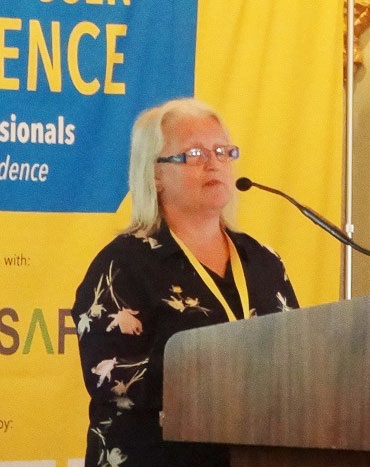 June joined Buckinghamshire in 2002 and is responsible for the delivery of road safety education, training and publicity across the county.
June joined Buckinghamshire in 2002 and is responsible for the delivery of road safety education, training and publicity across the county.
She qualified as a DVSA approved driving instructor (ADI) in 1995 and also holds a fleet licence, and recently qualified as an Energy Savings Trust (EST) ecodriving trainer.
June is primarily involved with the development, delivery and evaluation of driver training workshops and assessments which includes young drivers, business drivers, motorcyclists and Buckinghamshire’s Mature Driver Assessments.
Presentation: Be a better driver – mature driver assessments
“Buckinghamshire has the highest rate of growth among residents in their 80s and 90s of all county councils”
We identified four areas to consider with regards to the driver and the assessment:
- Vision – fields of vision, night vision, common eyesight problems
- Doing – ability to turn and move, strength to operate the vehicle, fatigue & use of medication
- Thinking – cognitive impairment, reactions, drugs that impair cognition
- Emotions –levels of anxiety, stress
The assessment scheme has four steps:
Step 1: Assessing an older driver by use of simple assessment tools and an observed drive
Step 2: Provide targeted information, feedback and advice
Step 3: Suggest possible coping strategies to minimise risk
Step 4: Assist in maintaining the mobility of an older driver by the development of a non-driver plan
“As well as an eyesight check we also record when they had their last eye test”
“The drive is ‘client centred’, based on the type of driving they normally do and what they want to achieve”
“The report is then sent to the driver and we encourage them to show a copy to their doctor”
Options the assessor can give the client at the end of the drive:
- Satisfactory, (95%)
- Satisfactory with some areas of concern (4%)
- Unsatisfactory (1%) – this recommendation would be to retire from driving
“Generally an unsatisfactory result is not a surprise for the driver or their family, its confirmation of their suspicions”
“One of the most important aspects (of the scheme) was getting the right people (ADIs) to deliver the scheme”
“Many older drivers don’t understand the technology on their vehicles”
“Mobile phone use affects older drivers as well as other drivers”
“We encourage them to use public transport now in preparation for the time they may have to give up driving”
Who takes part?
- More than 600 drivers since 2012/13 – averaging about 100 per year
- 61% are male
- 38% in their 70s
- 45% in their 80s
- 8% in their 90s
- Oldest is 98 years
- 36% are re-assessments (people coming back of their own accord)
- 25% are medical referrals
- 37% are promotional –and about 2% word of mouth
Evaluation
- Send out evaluation forms to all those that complete an assessment and the return rate is about 66%
- They gained insight into use of mirrors, speed and dealing with roundabouts
- The evaluation highlighted areas for change in relation to vision and hazard perception.
15.00 – Sergeant Rob Heard, Older Drivers Forum
 Sergeant Rob Heard is the founder and chairperson of the Older Drivers Forum and the road safety sergeant for Hampshire and Thames Valley Police.
Sergeant Rob Heard is the founder and chairperson of the Older Drivers Forum and the road safety sergeant for Hampshire and Thames Valley Police.
Rob has been in the police force for 29 years and is passionate about road safety. He is an advanced police car driver and motorcyclist and leads the Hampshire and Thames Valley force’s VIP escort team.
Rob instigated the Older Drivers Forum following a number of serious incidents involving older drivers. After extensive research he saw a real need to help and support older drivers to drive safely for longer.
Presentation: Driving Safely for Longer
Three-pronged approach to helping older drivers:
- Raise awareness
- Offer Voluntary Driving Assessments and encourage regular eyesight tests
- Create a purpose built Referral scheme
‘Older people are keen to know – they want info’
Older Drivers Forum aims to:
- Provide those who wish to continue driving with practical advice
- Inform older drivers about the risks they face and ways to reduce them
- Identify when the time has come to retire from driving and offer relevant advice
- Give advice to family, friends, medical practitioners and opticians
Raising awareness
- Dedicated website – www.olderdriversforum.com
- National website – www.olderdrivers.org.uk
- Local advertising – GP Surgeries, Libraries, Community Halls, • • Newspapers, TV and Radio
- Week-long roadshow
‘80% of 80 year olds use the internet regularly’
‘If you do less than 2k miles per annum it’s cheaper to use taxis’
Eyesight
- Encourage older drivers to have regular eyesight tests
- Older motorists often avoid driving at night because they can’t see so clearly
- At the age of 15 your eyesight will recover from glare in 2 seconds, whereas at 65 this will increase to around 9 seconds.
- 33% of people over 40 are affected by glaucoma, cataract, blindness, age related macular degeneration
‘We want a proper optician’s eyesight test to replace the current driving test eyesight check’
“A purpose built ‘Fitness to Drive’ assessment has been created as an alternative to prosecution for a Careless Driving offence”
Result of assessments:
- ‘Safe Outcome’ – no further action required
- ‘Unsafe Outcome’ – detailed report sent with original offence details to DVLA by the police (80% have licence subsequently revoked)
- ‘Unsafe review’ – client sent for lessons to come back within 3 months for free review (around 50% then give a ‘Safe Outcome’)
Reduction in injury collisions and reports (in last 5 years):
- Nationally KSI’s for 70-79 year olds has increased 15%, 80+ increased by 20%
- Hampshire KSI’s for 70-79 year olds has decreased by 30%, 80+ decreased by 15%
- Reports to Hampshire Police involving older drivers being at fault have decreased by 50%
“Why don’t you set up a Forum in your area?”
14.30 – Question Time
Panelists:
- John Plowman, Chair of the Older Drivers Task Force
- Dr Kit Mitchell, Consultant to the Road Safety Foundation
- Dr Carol Hawley, Associate Fellow, Warwick Medical School
- Graham Mylward, Senior Road Safety Officer, Hampshire County Council

What can we do to prepare people for giving up driving?
- When you are looking for somewhere to live after 60 years, plan to live somewhere where you don’t need a car.
- Use public transport before you pack up driving
- Involve the family
- Communication – GPs primary source of guidance, more open dialogue
- Black boxes could give older drivers a warning
How do we get Government to take older drivers seriously?
- Minister for older drivers to take responsibility
- Solutions are holistic (transport, social, medical issues, needs addressing cross government)
GPs will not become involved in preparing people to give up driving (because of lack of time) – is a cultural issue
- This is a problem
E-bikes for older people – good or not?
- One idea, may be other/better options
- Cycling on A roads is much more dangerous – educate older cyclists to avoid dangerous roads
Surely employers would be one place where you could reach older drivers?
- We try to publicise to employers what changes might happen
Should it be mandatory to go on a course at the age of 70 years?
- Research suggests this doesn’t do any good
- Older drivers self regulate / compensate
- Strongly in favour of a voluntary approach
- DVLA could suggest drivers take a voluntary assessment (but it will be the ones who are fine who will volunteer…)
- Maybe be a case of getting beyond a tipping point for voluntary assessment
- Could make people go on a workshop
- Make it standard practice to have a black box in older drivers’ cars
- When there is a choice older drivers shy away from roads they are not comfortable on – which they’d have to drive on in a mandatory course
Are there things we could do to improve the referral process?
- DVLA referrals show high level of unsafe – police referrals show more safe than unsafe
Vocational drivers – what approach should we take as they get older?
- Tougher medical rules, so problem drivers get ironed out at an early stage
- No research on fitness to drive for older vocational drivers
- Age discrimination makes it difficult to tackle this issue
How are you going to sell me the concept of a driverless vehicle?
- Once they’re proved to be safe I can’t wait for one
- Aviation is automated, and safe
- Give people who cannot drive more of a social concept
14.15 – Julia Chen, Senior Policy Adviser, Centre for Connected and Autonomous Vehicles
 Julia Chen joined the Centre for Connected and Autonomous Vehicles in 2017. She leads on the Future of Urban Mobility Strategy, one of the initial priorities of the Future of Mobility Grand Challenge established in the Industrial Strategy.
Julia Chen joined the Centre for Connected and Autonomous Vehicles in 2017. She leads on the Future of Urban Mobility Strategy, one of the initial priorities of the Future of Mobility Grand Challenge established in the Industrial Strategy.
Previously Julia worked on clean electricity policy at the Department for Business, Energy and Industrial Strategy.
Presentation: A Grand Challenge: The Future of Mobility in an ageing society
Ageing Society Grand Challenge
“Ensure that people can enjoy at least five extra healthy, independent years of life by 2035, whilst narrowing the gap between the experience of the richest and poorest.”
“Around 1/3rd of older people have unmet travel needs”
‘Four key changes taking place in transport: automation, electrification, new business models and new modes (drones etc)’
‘Automation of bus services could significantly reduce costs and therefore increase services’
‘E-bikes could help people enjoy the benefits of cycling into older age’
‘Future mobility technologies must place inclusive design to the fore’
“The deployment of CAVs could significantly increase access to mobility for those who are too young, old, disabled, impaired or otherwise lacking a driving licence, for whatever reason…”
“Delivery of the Inclusive Transport Strategy – by 2019, we will request that local highway authorities help improve local journeys to and from hospital for disabled and older people by actively considering the location of bus stops and routes”
“We’ll be producing a Future of Urban Mobility Strategy, which will set out a vision for how emerging technology and services can help achieve city goals, and outline the principles Government will apply to try to realise that vision.”
“Older vulnerable road users are one of four priority user groups – alongside young people, rural road users, and motorcyclists – for the road safety action plan being developed by the DfT.”
14.00 – Stuart Millward, CEO, Satsafe
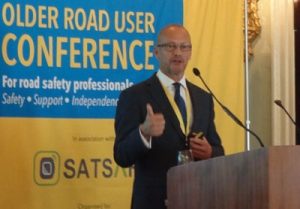 Stuart Millward is the founding director of an award-winning InsurTech Company developing innovative, GPS-enabled safety, security and business management solutions for insurers and fleet managers. Stuart spent 12 years working in a technical corps of the British Army and left as a captain in The Parachute Regiment.
Stuart Millward is the founding director of an award-winning InsurTech Company developing innovative, GPS-enabled safety, security and business management solutions for insurers and fleet managers. Stuart spent 12 years working in a technical corps of the British Army and left as a captain in The Parachute Regiment.
Presentation: A new driver monitoring system: an older driver research project
Technology start-up developing innovative, GPS-based products and services that provide safety and security benefit to our customers
A nationwide initiative to explore the potential for aftermarket in-vehicle technologies to provide safety and security benefit to elderly drivers in order to keep them on the road safer for longer
Phenomenal response from older drivers volunteering to be part of the pilot – expanded from Manchester to a national project
Value added services
- Driver behaviour monitoring
- Crash detection and reporting
- Geo-Fence – Report when home or out of area
- Low fuel reporting (leaving home)
- Fault reporting – low battery etc
- Video evidence in case of non-fault accident
- Potentially lower-cost insurance – PAYG
Shifting the balance
- From crisis response
- To early appropriate intervention
12.40 – Dr Chris McGinley, Research Fellow, Helen Hamlyn Centre for Design
 Dr Chris McGinley is an award-winning designer, researcher and writer. He is a Research Fellow at the Helen Hamlyn Centre for Design, where he leads the Age and Diversity research space, managing projects in the fields of technology, product, service and transport for a global client base.
Dr Chris McGinley is an award-winning designer, researcher and writer. He is a Research Fellow at the Helen Hamlyn Centre for Design, where he leads the Age and Diversity research space, managing projects in the fields of technology, product, service and transport for a global client base.
Presentation: Design inspired by an ageing world
Age & Diversity Research Space
The role of DESIGN and EMPATHY to IMPROVE LIVES considering the broadest dimensions of AGE and DIVERSITY
Inclusive design
An approach to the design of mainstream products and services that are accessible to and usable by as many people as reasonably possible, without the need for adaptation or specialist design.
‘We are looking to get the question right before we design anything’
Lessons on – design thinking and the city
- We need to answer the right questions… towards this we should seek to understand those we design for, and the potential to impact their lives.
- Learn from the people you are designing for and with… everyone has something unique to contribute.
- Information is useful… … empathy can be insightful and inspirational
- Design thinking used the right way…… can help you envision what a future could and should be.
Age in the UK
- Life expectancy at birth is increasing year on year. More years are a given for most of us. It is predicted that half of all children born in the UK today will live to be 103.
- The question is, how we will live those years?
- Will we enjoy independence and good quality of life? Or will we become isolated and marginalized?
- Design thinking has a definitive role to play in supporting an ageing society.
12.20 – Stephen Joseph OBE, Advisor, Campaign for Better Transport
 Stephen Joseph was executive director of Campaign for Better Transport from 1988 until earlier this year. His wide-ranging expertise and contacts have helped to make the organisation the country’s leading transport NGO.
Stephen Joseph was executive director of Campaign for Better Transport from 1988 until earlier this year. His wide-ranging expertise and contacts have helped to make the organisation the country’s leading transport NGO.
The last 20-plus years have had many highlights for Stephen, including persuading the Treasury to cut the road-building programme in the 1990s, campaigning for increased rail investment and new/ reopened lines and stations, and highlighting the importance of buses and the impact of cuts in bus services.
Presentation: Better mobility for older people
More older people driving…but what happens when they can’t?
- Access to key services limited
- Cuts in bus services
- Places designed around cars and car use
- Public realm hostile to non-car mobility
… resulting in isolation and exclusion
45% reduction in funding for bus services across England and Wales (2010-11 to 2017-18)
Transport for New Homes review – key findings
- New homes often cut off from surrounding areas (with no pavements)
- Car-based living with resulting congestion
- Minimalist public realm, limited local facilities
- Public transport often poor or absent
‘We are now building American style housing developments with no pavements….very difficult environments for people without cars.’
Hostile public realm
- Pavements not maintained well and low priority for repair and gritting
- Short crossing times for pedestrians
- Cycling not treated s a transport mode for older people
Result: isolation, loneliness and ill health
‘There are new developments where better practice does exist (Kidbrooke, Poundbury & Kilwood Vale (extension to Crawley))’
‘Walking & cycling need to be treated as main modes of transport’
Ways forward
- Plan new developments better
- More and better bus services
- More funding for road and pavement maintenance
- Cycling policy as if older people mattered
Key lessons
- Think about transport at the beginning – access for all modes
- Talk to bus operators/ authorities from the start
- Plan for something other than 100% car use
- Conventional transport modelling won’t be very helpful
- Walking and cycling as main modes
- Mixed use, good local facilities
- High quality public realm, not huge car parks
- Involve local people
Cycling for older people
- Cycling seen as for young fit men who run over older people on pavements
- In the Netherlands around 25% of journeys made by women over 60 are by bike
Conclusions
- Strategies for an ageing population need to offer alternatives to a car-based lifestyle
- Better access to services
- Better planning and design of places and housing
- Better bus services with new forms of funding
- Increased priority for pavement maintenance
- Better public realm with high quality walking routes
- Make it easy and natural for older people to cycle
Reducing car dependence will address other problems and help other groups too
12.00 – Dr Julie Gandolfi, Driving Research Ltd
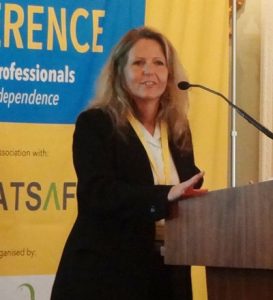 Julie is a Chartered Psychologist, with undergraduate and Masters degrees in psychology. Her PhD from Cranfield University focused on psychometric assessment of police driver risk.
Julie is a Chartered Psychologist, with undergraduate and Masters degrees in psychology. Her PhD from Cranfield University focused on psychometric assessment of police driver risk.
In 2007 Julie founded Driving Research Ltd., specialising in consultancy incorporating psychological theory and research into the development and evaluation of road safety initiatives and attitudinal and behavioural driver assessment and training.
Presentation: Maximising compatibility between the older driver and the traffic environment
Perception countermeasures
- Clear, intuitive warning signage and road markings
- Path guidance e.g. rumble strips
- Advance warning of bends
- Use of minimum curve length and maximum sharpness
Observation countermeasures
- High-contrast road markings
- Maintenance to keep contrast ratio up
- Signage placed in central visual area
- Chevron plate delineators in bends
Many pieces of engineering advice focus around:
- Widening or adding turn lanes and increasing the length of slip roads
- Widening lanes and hard shoulders to reduce the consequence of driving mistakes
- Making bends more gradual and easier to navigate
= making roads wider, straighter, and faster
But how will this help the older driver?
Latest research
- Older drivers tend to avoid motorways – the widest, straightest, fastest roads
- Many older drivers (over 75) still engage in frequent speeding behaviour
‘Where do we draw the line in the sand in terms of what is an older driver? (in terms of age?)’
‘We’ve got to make the road system work for everyone’
‘Older drivers are not a homogenous group’
‘Self regulation (for older drivers) is key’
Stress & confidence
- Self-regulation can be a reaction to discomfort in stressful driving conditions, rather than intentional self-monitoring
- Drivers can attribute discomfort and stress to external causes (i.e. glare sensitivity, changes in the road systems, vehicle technology issues) rather than possible declines in driving ability
- Stress itself further compromises driving performance
Technology can be effective in reducing older driver risk…
- Trip Diary
- Feedback on trips driven, low-risk route alternatives, and frequency of risky driving behaviours along a driven route
..as long as it is the right technology and they (older drivers) are comfortable with it
Tackling older drivers
- 5th level of the GDE (goals for driver education) – social level – particularly relevant to older drivers as well as young drivers
- Influencing factors:
- Goals and norms associated with the social group
- Peer feedback
- Self-perception around driving cessation – independence, self-worth, social connection, household composition
- Just 2 hours of tailored driving lessons using the GDE framework can reduce unsafe behavioural choices in an older driver cohort
‘Personalised feedback and coaching are the most important things we can do with older drivers’
Summary
- Engineering – behavioural adaptation – new problems
- Young drivers ——- Old drivers: Where is the line?
“Effective self-monitoring and behavioural awareness is the key: essential skills for life, from the first drive (of a young driver) to the last (drive of an older driver)”
11.40 – Edward Trewhella, CEO, Driving Mobility
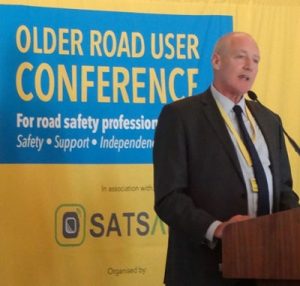 Edward Trewhella is chief executive of Driving Mobility, a network of 16 independent organisations covering England, Scotland, Wales and Northern Ireland, which offer professional, high quality information, advice and assessment to people who need to gain or retain independence through mobility.
Edward Trewhella is chief executive of Driving Mobility, a network of 16 independent organisations covering England, Scotland, Wales and Northern Ireland, which offer professional, high quality information, advice and assessment to people who need to gain or retain independence through mobility.
Presentation: Medical fitness to drive assessments as a means of establishing and addressing the needs of older drivers
Licence holder’s duty
“ If at any stage during the period for which his/her licence remains in force, a licence holder becomes aware.. That he has a relevant or perspective disability…the licence holder must notify the secretary of state of the nature & extent of the disability”
Great Britain
- 36.8M licence holders >65 or declared mobility issue
- Whole UK – 94% within a 1 hour drive of a Mobility Centre
- England – 64% within 30 minutes drive of a Mobility Centre
What do we offer at our centres?
- Car driving assessment
- Group 2 vehicle assessment (LGV & PSV)
- Motorcycle assessment
- Driver/passenger access/seating assessment
- Wheelchair/scooter loading assessment (including WAV)
- Driving tuition service
- Older driver improvement
- Paediatric assessment for car seating (including restraints) and powered wheelchairs
- Postural support seating solutions for air travel
‘Every assessment is clinically led – by a clinician and an ADI’
‘There is a binary decision at the end – either you are safe to drive, or not’
Alternative mobility options
- Access to Work Scheme
- Mobility Allowance
- Bus Pass
- Senior Railcard / Disabled Persons Railcard
- Assistance with Holiday Travel
- Community Transport Services
- Taxi Card / Token Schemes
- Mobility Scooters
- Shop Mobility
- Delivery of Shopping
‘We produce a source of national data which can be mined by stakeholders’
‘Dementia and stroke are the two largest diagnostic outcomes that lead to a referral’
‘Stroke victims and people suffering from dementia (over 55 years old) – quite a high proportion of referrals are judged unfit to drive’
10.45 – Professor Dilwyn Marple-Horvat
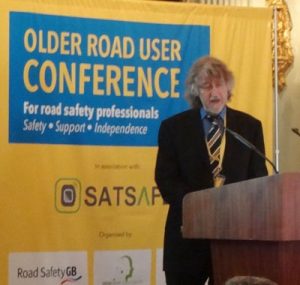 Dilwyn Marple-Horvat is Professor of Motor Neuroscience in the School of Healthcare Science at Manchester Metropolitan University.His research investigates how the brain uses sensory information to guide what we do.
Dilwyn Marple-Horvat is Professor of Motor Neuroscience in the School of Healthcare Science at Manchester Metropolitan University.His research investigates how the brain uses sensory information to guide what we do.
Recent work has focused on algorithm-based automatic in-car detection of impaired driving due to different factors, including alcohol, and medical conditions such as diabetic peripheral neuropathy, with the aim of reducing the crash statistics associated with any impairment.
Presentation: Driving with diabetic peripheral neuropathy (DPN): particular problems and possible solutions
Two growing challenges
- More older drivers who are at greater risk of crash per driver or per mile driven
- More people with diabetes: 9% of adult population, 3.8m people, mainly type 2; half will develop diabetic peripheral neuropathy (1.5m people)
Particular problems when driving with diabetic peripheral neuropathy
- It affects cutaneous sensation – the ability to feel the pedal under your foot and how hard you are pushing down on it
- It affects proprioception – the ability to judge the position of your foot and how far the pedal is pushed down
- It affects the ability to push down on the pedal
Any or all of these might lead to difficulties in operating accelerator, brake and clutch, and so to impaired ability to control the vehicle.
The study that is the subject of this presentation compared three groups of drivers aged 60+ years:
- Control
- Diabetes
- Diabetic peripheral neuropathy
The Diabetic Peripheral Neuropathy group showed:
- Reduced ankle position sense and impaired muscle function
- Use of the accelerator was less well controlled, involving more use of extreme (high and low) pedal positions than other drivers
Despite driving slower, they experienced more loss of control than other drivers
- The improvement between drives 1 and 2 indicates the potential for training and familiarisation with routes to improve pedal control
Possible solutions
- Clinic-based intervention: Diagnose, Inform, Train with feedback
- Algorithm based automated driver assistance system: Enable the driver to overcome the effects of the neuropathy and drive more like a healthy driver
- Intervene to reduce the risk of loss of control
- Modify the vehicle to switch from foot to hand controls
10.25 – Dr Lily Read, Community Mental Health Team for Older People, Northamptonshire Healthcare NHS Foundation Trust
 Dr Lily Read works in old age psychiatry and has had an interest in driver safety for several decades. Her main interest is in the balance between mobility and safety and ageing +/- illness.
Dr Lily Read works in old age psychiatry and has had an interest in driver safety for several decades. Her main interest is in the balance between mobility and safety and ageing +/- illness.
She has previously worked as the Medical Adviser and Research Manager for medical fitness to drive and medication/drug driving at the Department for Transport and a Senior Researcher at the Institute for Transport Studies at the University of Leeds.
She obtained a PhD is psychiatry and psychology on predictors of driving safety in later life and dementia and has been a member of government and European advisory bodies in these areas.
Presentation: Older people who drive: the competing needs for mobility and safety
‘Road safety has become part of a medical doctor’s remit’
‘Only a small percentage of people aged over 65 years are frail and doddery’
Trends
- At the 2011 census, 9.2m people in UK were age 65 and over -almost 1m more than 2001 census
- 16% of population were age 65 or over – unchanged from 2001
- More older people live as couples (married or cohabiting) and fewer live alone (31%) -10 years earlier this was 34%.
- 50% reported their health as good or very good, compared to 88% for those aged under 65 years.
- Driving licence possession in people over 65 years has steadily increased
Time to think differently (Kings Fund)
- Between 2012-2032 the population in England is predicted to grow by 8m
- By 2032 11.3m people are expected to be living on their own, more than 40% of all households
- The number of people over 85 years living on their own is expected to grow from 573k to 1.4m
- In 1901 baby boys were expected to live for 45 years and girls for 49 years. In 2012, boys could expect to live for just over 79 years and girls to 83 years
- By 2032 this is expected to increase to 83 years and 87 years respectively
- Healthy life expectancy is growing at a similar rate, suggesting that the extra years of life will not necessarily be years of ill health
- The population aged over 65 years is growing at a much faster rate than those under 65
- Over the next 20 years the population aged 65-84 years will rise by 39% and those over 85 by 106%
- Men and women in the highest socio-economic class can, on average, expect to live just over seven years longer than those in the lowest socio-economic class, and more of those years will be disability free.
‘We talk about older people as one group, but diversity among older people is huge’
Older drivers – risk
- Involvement in fatal crashes, per mile travelled, begins increasing among drivers ages 70‒74 years and is highest among drivers aged 85+
- This trend has been attributed more to an increased susceptibility to injury and medical complications among older drivers rather than an increased risk of crash involvement
- Across all age groups, males have substantially higher death rates than females
- Age-related declines in vision and cognitive functioning (ability to reason and remember), as well as physical changes, may affect some older adults’ driving abilities
Compensatory behaviour
- High incidence of seat belt use (among older people)
- Tendency to drive when conditions are the safest (older drivers limit their driving during bad weather, at night, and on high-speed roads)
- Older drivers are less likely to drink and drive than other drivers (but I’m not sure this is going to be true going forward because older people a drinking more alcohol)
‘Older drivers self regulate quite a bit’
Impairing factors
- Increased frailty
- Ageing eye, hearing, cognition, musculoskeletal problems
- Prevalence of impairing medical conditions
- Risky behaviours that other age groups also engage in (they are not all sweet little ladies who obey the law…)
Driving later in life – roles
- Practical role: getting to places safely, fast, comfortably, transporting goods, accessing services
- Psychological role: identity, self worth, status, freedom, control over own life, independence, maintaining social networks and being useful to others, pleasure in exploring the world (this is the one that does most damage when people have to give up driving)
Driving cessation
- Linked to depression, reduced quality of life and increased mortality
- Huge negative impact
- Better solutions for practical role of driving (but not perfect by far) than psychological role (very limited solutions at present)
Conclusions
- Keep older drivers driving safely for as long as possible
- Supportive car adaptations/ technology likely to be more successful in addressing the diverse needs of ageing drivers
- Education/ support tailored to individual very helpful
- Effective support for those giving up driving is crucial
10.05 – Dr Charles Musselwhite, Associate Professor in Gerontology, Centre for Innovative Ageing, Swansea University
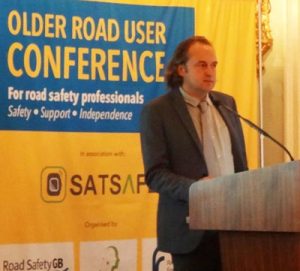 Dr Musselwhite is associate professor in Gerontology at the Centre for Innovative Ageing (CIA) and heads up the group’s Environments and Ageing research strand.
Dr Musselwhite is associate professor in Gerontology at the Centre for Innovative Ageing (CIA) and heads up the group’s Environments and Ageing research strand.
He is Operational Director of the Centre for Ageing and Dementia Research (CADR), an initiative to develop and enhance research, policy and practice for older people across Wales.
He has published more than 25 journal articles and another 40+ publications and has been involved in research projects totalling more £6m addressing technological, environmental, health and sustainability contexts of transportation and built environment studies spanning four interconnected areas – including road user safety and ageing.
Opening keynote
“The desire to get out and about does not diminish in older age, nor does the variety of activities people like to do outdoors”
“More older people are doing more journeys as car drivers (over the last 15 years)”
Mobility is important for health and giving up driving is seen as a major life event and is related to:
- A decrease in wellbeing
- An increase in depression and related health problems, including feelings of stress, isolation
- Increased mortality
Solutions
- Keep older people on the road later in life
- Provide better alternatives to the car
- Reduce literal mobility (are there things we can do to reduce this mobility)
Public call for testing & training
- 50% think older drivers should be tested at least every 2 years
- 66.3% think older drivers should pass road safety training frequently
Stereotypical image/perception of older drivers being dangerous drivers…yet older drivers, on the whole, are safe drivers
“Specific issues with older drivers turning right at a junction, and with low mileage older drivers”
Self assessment and declaration (in the UK)
- Drivers aged over 70 have to reapply for their licence every three years
- There’s no test or medical, but they do have to make a medical declaration that may lead to further DVLA investigations
Testing – no evidence it works
- Across Europe, Netherlands and UK have lowest fatality rates and the most relaxed procedure
- Across USA no differences found in states with stringent testing (except states with increased eyesight testing)
- Denmark introduced cognitive screening – no effect on collision rates (in fact increased for older pedestrians). Denmark stopped screening in March 2017
- Sydney -practical assessment at 80 (now 85), more collisions than Melbourne (no age related assessment)
Change the infrastructure – extra attention to:
- Merges onto main roads (protected lanes, longer slips)
- Edge and lane markings
- Intersections (roundabouts not T-junctions, stop and give way signs, traffic signals)
- Signage (larger lettering, better reflection)
Change the vehicle – towards driverless or automated vehicles:
- Informative systems
Much preferred
Head-up displays
Prioritise and manage displays
- Advisory systems
Warning messages liked if understood
Somewhat liked
- Take over systems
Potentially most useful but least liked
Improved when used!
Enhance compensatory behaviour
- Dialogue and information: family and friends, doctors, GP, health professionals, DVLA, public information
- Nudge (Can Older Drivers Be Nudged?)
- ‘Graduated’ licencing or insurance: incentives for avoiding difficult situations
‘There is no one solution for keeping drivers safe on the road for longer’
Policy: Importance of older people’s travel isn’t recognised
- Travel time seen negatively
- Geared around economic growth, 9-5, core (rush) hour provision
- Provision for car dominates, public transport suffers
Public bus important and liked by older people, but there are issues:
- Bus driver awareness (surly or hostile)
- Having to change buses
- Bus stop not near main residential areas
- Buses being cancelled or reduced in number
- Unreliability of service
- Poor bus stops (signage, information, seating and shelter)
- Early finish of buses in afternoon
- Safety and security issues at bus stop or on bus itself
- Poor quality buses (do not lower to kerb/grab rails missing)
- Need free bus all day long, not just after peak time
Barriers for older pedestrians
- Poor quality pavements
- Obstructions on pavements
- Pedestrian crossings
- Speeding traffic
- Lack of benches and toilets
- Poor street lighting
- Pollution
‘Only 11% (of older peds) walk as fast or faster than DfT recommendations for pedestrian crossing time’
‘ Older people prefer pelican crossings to puffin crossings’
Conclusions
- Older people are not especially dangerous drivers
- But they do have unique issues that result in unique challenges (e.g. turning right, low mileage drivers)
- Medical screening and testing doesn’t make much difference, but infrastructure design, regulation and education and training might hold the key, more research needed
- Alternatives are unsafe and also unattractive, especially a risk of falls – and crossing places and times need adjusting
- What is so special about literal mobility and especially the car? Can it ever be substituted or replaced?
09.45 – Dame Joan Bakewell CBE
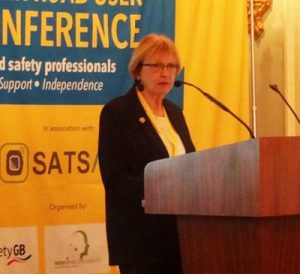 A journalist, television presenter and Labour Party Peer, Dame Joan Bakewell’s 64-year career in the media began in 1954 when she took up the post of studio manager with BBC Radio.
A journalist, television presenter and Labour Party Peer, Dame Joan Bakewell’s 64-year career in the media began in 1954 when she took up the post of studio manager with BBC Radio.
In 1962 she made her first television broadcast as a contributor to BBC TV’s Table Talk, and between 1965-1972 she was one of four presenter-interviewers for the BBC 2 nightly programme Late Night Line Up.
She currently presents BBC Radio 4’s We need to talk about death, and previously presented Inside the Ethics Committee, also on Radio 4, and the BBC Radio 3 Belief series.
Joan was made a CBE in 1999 and Dame in 2008. In January 2011 she took her seat in the House of Lords as Baroness Bakewell of Stockport.
Opening address
Older people
- Move slowly and hate being rushed
- Have bad feet and trouble walking, and more likely to trip up
- A number will be using sticks or wheelchairs
- Many are deaf or hard of hearing
- Others have impaired sight
- Panic easily, feel overwhelmed by the world of younger people (and overlooked)
- Hate stairs, and depend on railings
- Feel as if they are the victims of the world around them
- May still drive a car, but probably don’t cycle
- Fearful of cyclists and lorries
- Grateful for any generous behaviour. Welcome being helped…enjoy contact with other people
Old drivers passed their test years ago and aren’t familiar with the latest updates of the Highway Code – I think they should have to take another test
Road surfaces
- Unpredicatable bumpy surfaces can cause falls
- Pavements with humps to warn the blind, can hurt old feet
- Kerbs need to be even and well marked, possible have dips
Traffic
- Traffic is their enemy – as is the speed of life
- Old people feel other road users are often hostile to them
- The speed is too great: there is not enough pause
- Traffic lights don’t allow enough time between signals to wait and to cross and back again
Older drivers
- Know that other drivers will overtake and nudge them out of the way. Best to give way!
- Old drivers may not be familiar with the latest tricks of modern cars.
Parking
- Some older drivers don’t have mobile phones to book parking space
- If they do, they can’t always hear instructions over the noise of traffic
- They can find instructions baffling and time consuming
- They hate not talking to a human voice!
WHAT’S TO BE DONE?
- I don’t think the answer is more street furniture, signs or information
- The solution lies with people themselves
- We need to make everyone better road users, that will help older people
- Organise pavements so older people will be walking with the flow
- The Japanese are giving this some thought/attention
Comments from the floor
Highways engineers can do more to design out the elements of the roads that are dangerous
Crossing the road – there is a national standard for time to cross the road and many crossings are intelligent and detect the speed at which people are crossing the road
Human voices – the most popular voice has a Geordie lilt to it!
09.30 – Liz Box, Head of Research, RAC Foundation
 Introductory remarks
Introductory remarks
• 200 in every million people in the UK are aged over 100 years
• The number of centenarians has increased by 65% in the past decade
• 18% of the UK population is aged over 65 years – by 2040 this will have risen to 25%
• The healthy life expectancy of people living in England today is 64 years
• 64% of those aged over 70 years hold a driving licence
• Loneliness can increase risk or premature death by up to 25% – and be as harmful as smoking 15 cigarettes each day
• 8.42m people aged 50-64 years – and 3m people aged 65+ – are in employment
08.30 – Welcome to the Older Road User Conference live feed
Soundbites to begin from around 9.30am – when the conference gets underway!
Fully agree Graham – in those circumstances it could do more harm than good. Perhaps a campaign to promote automatics generally more is what’s required, so that they become the norm rather than the exception, as has been the case in many countries for years.
Hugh Jones
--1
I tend to agree about the benefits of left foot braking where someone is used to this method over a long period of time but not as an intervention for, as an example, a rather frail 85 year old where I feel there is a higher risk in trying to change someone’s habits of a lifetime.
Graham Mylward, Winchester
+2
Those situations are avoidable with left-foot braking Graham, which again takes time to master, however in the US where opinion is split on left-foot/right-foot braking, campaigners for the former method claim many deaths and injuries would have been prevented if the former method had been instilled in the driver.
Hugh Jones
--1
Hugh, I do support the idea of automatics in many circumstances but we have dealt with several cases recently of pedestrian fatality due to pedal confusion. There seems to be a link between this type of incident, which I believe is the tip of the iceberg (many other instances with no damage done)with a slowness of thinking. After yesterday’s talk by Professor Dilwyn Marple-Horvat I’m wondering whether conditions such as diabetic peripheral neuropathy which causes proprioception will make this more likely. We have certainly stopped recommending automatics to some drivers without a visit to a driving mobility centre for a comprehensive assessment first.
Graham Mylward
0
For ease of driving around town, apart from simplified transmission, I should also have added very light steering. I think poor choice of car and advice may possibly deter some drivers and affect their confidence to be in full control and drive safely.
Hugh Jones
0
Noted Graham, however two feet to operate three pedals of differing sensitivity and feel is not an ideal scenario anyway. Obviously anyone – not just the elderly – switching to autos would have to do it cautiously at first, under supervision if necessary and get used to it.
Hugh Jones
--7
Automatics are an interesting subject where older drivers are concerned. Although they have many benefits there is a word of caution here. One of the largest problems for older drivers in terms of other road user fatality is pedal confusion where the accelerator is hit instead of the brake pedal an automatic car. More research is needed but my limited look at this suggests that the combination of an automatic gear box and certain medical conditions increases the risk of pedal confusion. All electric cars are automatic and accelerate rapidly in some cases.
Graham Mylward, Winchester
+8
Many older drivers (unless they’ve always been well-off) have probably been brought up on manual transmission cars and have no idea of the benefits of autos to make they’re driving easier and should be encouraged more.
Hugh Jones
0
> ‘We are now building American style housing developments with no pavements….very difficult environments for people without cars.’
That’s an incredibly pessimistic way to view shared space initiatives(!)
But in all seriousness, the biggest thing I’ve found about encountering aged drivers is not their ability, but the massive stigma/guilt regarding referring someone who in essence is now a vulnerable adult, to organisations like the DVLA due to their condition.
David Weston, Corby
0